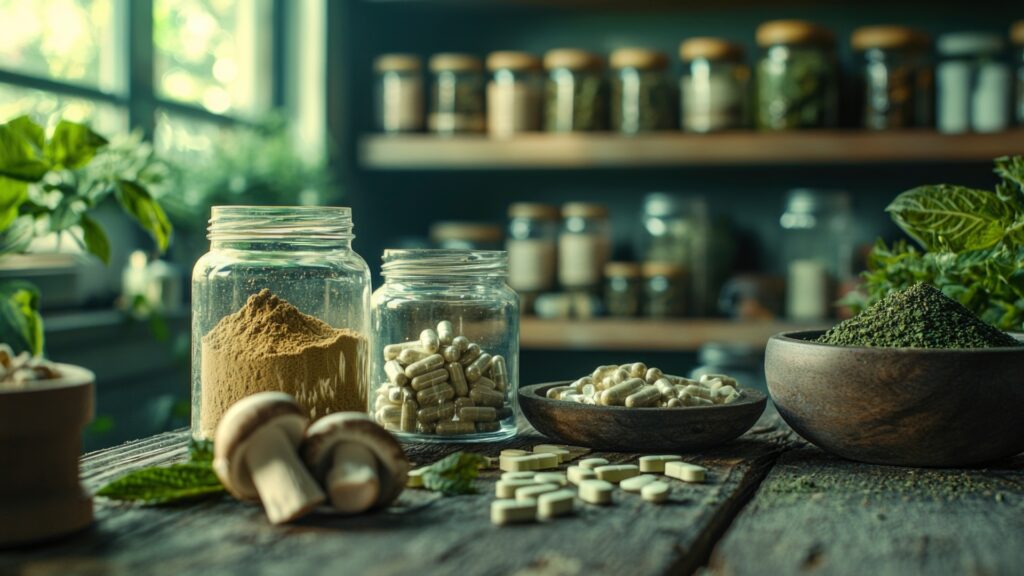If you’ve ever browsed the world of kratom, you’ve likely noticed two main options on the market: kratom powder and kratom extract. Although both are extracted from the same Southeast Asian tree, Mitragyna speciosa, they may vary significantly in their preparations, strength, and applications.
As a new or an experienced user, it is indispensable to learn the difference between kratom extract and powder so that you can make informed choices about which types you can use that befit your interests.
This is an ultimate step-by-step guide to kratom powder vs extract, the advantages of using it, the disadvantages, and the most important question of all: how much kratom extract can be used?
What Is Kratom Powder?
The most classic and most accessible type of kratom is the kratom powder. It is produced through picking, drying, and powdering of the leaves of the kratom tree, to produce a fine, greenish powder.
This is a powder that contains the entire range of natural alkaloids of kratom, like mitragynine and 7-hydroxymitragynine, which are the components that cause its effects.
Key Features of Kratom Powder
- Whole-Leaf Product: Contains all the plant’s natural components.
- Versatile: Can be brewed as tea, mixed with juice, or taken using the “toss-and-wash” method.
- Variety: Available in numerous strains (red, green, white, gold), each with unique effects.
- Affordable: Generally less expensive per dose than extracts.
- Customizable Dosing: Easier to measure and adjust to your needs.
Common Uses
- Energy and Focus: Lower doses can provide a mild stimulant effect.
- Relaxation and Relief: Higher doses may promote calm and ease discomfort.
- Mood Enhancement: Many users report improved mood and motivation.
What Is Kratom Extract?
The kratom extract is a type of kratom, which is achieved by boiling large amounts of kratom powder or leaves to extract the alkaloid, which is concentrated. What comes out is a product with a much stronger effect in a small serving portion.
Key Features of Kratom Extract
- Concentrated Alkaloids: Higher levels of mitragynine and 7-hydroxymitragynine per gram.
- Various Forms: Available as liquid tinctures, resins, enhanced powders, and shots.
- Potency Ratios: Often labeled with ratios (e.g., 10:1, 20:1), indicating how much raw material was used to make the extract.
- Smaller Doses Needed: Users require much less product to achieve the desired effects.
- Faster Onset: Effects may be felt more quickly and can last longer.
Common Uses
- Potent Relief: Used by experienced users seeking stronger effects.
- Convenience: Useful for those who want a powerful dose in a small, easy-to-consume form.
- Travel: Compact and portable for on-the-go use.
What are the Benefits of Kratom?
Kratom is extracted from the leaves of an evergreen tree known as Mitragyna Speciosa, which is native to Southeast Asia and belongs to the coffee family. It is the active alkaloids, at least 40 of them, and in particular, Mitragynine and 7-Hydroxymitragynine, that make Kratom have its own effect.
Depending on the strain and serving size, Kratom can provide:
- Natural energy
- Motivation and drive
- Relaxation and calm
- Pro-social attitudes
- Mental focus
- Relief of physical discomfort
- Elevated happiness
- Restful sleep
Kratom Powder vs Extract: Key Differences
Let’s break down the main distinctions between these two popular forms:
| Feature | Kratom Powder | Kratom Extract |
| Potency | Moderate | Extremely strong |
| Serving Size | Larger (2–6 grams typical) | Much smaller (often <1 gram) |
| Onset Time | 15–45 minutes | 5–15 minutes (liquid faster) |
| Duration | 2–4 hours | 4–6 hours or longer |
| Cost | Affordable | More expensive |
| Ease of Dosing | Easier to measure | It can be challenging to measure |
| Variety | Many strains available | Fewer options, but growing |
| Best For | Beginners, daily users | Experienced users, special needs |
Potency and Alkaloid Content
- Kratom powder contains the full spectrum of plant alkaloids, but in lower concentrations.
- Kratom extract is processed to concentrate these alkaloids, making it much more potent per gram.
Preparation and Use
- Powder: Simply mixed, brewed, or encapsulated.
- Extract: Undergoes additional processing (boiling, reduction, sometimes solvent extraction) to isolate alkaloids. Often used in enhanced blends or liquid shots.
Comparing Effects and Benefits
1. Kratom Powder
- Gentle, Balanced Effects: Because it’s less concentrated, powder offers a more gradual onset and smoother experience.
- Flexible Dosing: Easier to adjust dose to individual needs.
- Traditional Use: Closest to how kratom has been used in Southeast Asia for centuries.
2. Kratom Extract
- Stronger, Faster Effects: More intense due to higher alkaloid concentration.
- Longer Duration: Effects can last longer, especially with liquid extracts.
- Convenience: Small amounts needed; easy to consume on the go.
- Best for High Tolerance: Useful for those who have developed a tolerance to powder or need stronger relief.
Which Is Better?
It depends on your goals:
- For daily, moderate use: Powder is generally preferred for its flexibility and lower risk of side effects.
- For occasional, potent effects: Extracts are ideal for experienced users or those seeking strong relief in small doses.
How Much Kratom Extract to Take?
Understanding Extract Potency
Extracts of kratom are commonly denoted as ratios (e.g., 10:1, 20:1). When there is a 10:1 extract, this indicates that 10 grams of kratom powder was extracted into 1 gram of extract. This does not imply that it is 10 times stronger, but it is very strong compared to powder.
General Dosing Guidelines
Kratom Powder:
- Beginner dose: 1–2 grams
- Moderate dose: 2–4 grams
- High dose: 5–6 grams or more
Kratom Extract:
- Start low: 0.25–0.5 grams (or as directed by the product label)
- Increase slowly: Due to high potency, only increase in small increments
- Liquid extracts: Often measured in drops or milliliters; follow the manufacturer’s instructions
Important:
- Always start with the lowest recommended dose, especially with extracts.
- Potency can vary dramatically between products and brands.
- Overuse of extracts increases the risk of side effects and tolerance.
Measuring Extracts
- Powdered Extracts: Use a precise scale for accuracy.
- Liquid Extracts: Use a dropper or syringe for consistent dosing.
- Enhanced Powders: These are blends of extract and regular powder; dosing guidance should be on the label.
Choosing Between Kratom Powder and Extract
When to Choose Kratom Powder
- You’re new to kratom: Powder is easier to dose and less likely to cause overwhelming effects.
- You want flexibility: Powder allows you to tailor your dose and try different strains.
- You’re cost-conscious: Powder is more affordable for regular use.
- You value tradition: Powder is closest to the way kratom has been used historically.
When to Choose Kratom Extract
- You have a high tolerance: Extracts provide stronger effects for those who no longer feel the powder’s full benefits.
- You need potent, fast relief: Extracts are ideal for those seeking immediate, powerful results.
- You want convenience: Small doses, easy to carry, and quick to use.
- You’re an experienced user: Extracts are best reserved for those familiar with kratom’s effects and dosing.
Safety, Side Effects, and Best Practices
Potential Side Effects
- Powder: Nausea, dizziness, constipation, headache (usually at higher doses).
- Extract: Increased risk of side effects due to higher potency—nausea, vomiting, sedation, rapid tolerance, and dependence.
Avoiding Risks
- Start Low, Go Slow: Especially with extracts, begin with the smallest dose.
- Don’t Mix Forms: Avoid using powder and extract together unless you’re highly experienced.
- Monitor Your Response: Everyone’s body reacts differently; adjust as needed.
- Rotate Strains: Prevents tolerance and keeps effects fresh.
- Check Product Quality: Buy from reputable vendors who provide lab testing and clear potency information.
Who Should Avoid Extracts?
- New Users: The risk of taking too much is higher.
- Those Sensitive to Stimulants or Sedatives: Extracts can amplify both effects.
- Anyone with a History of Substance Dependence: Extracts’ potency may increase the risk of misuse.
Final Thoughts
Kratom extract or powder is the difference that depends on your experience, intentions, and possible preferences. Powder is traditional, versatile, and cheap- the qualities that suit the majority of consumers and activities.
Extracts, however, are very strong and are best suited to experienced users or people with special requirements.
Regardless of the form, however, safety should be your priority: start small, observe reactions of your body, and purchase only from sources you can trust.
Due to the analyzed discrepancies between kratom powder and extract, decisions based on informed choices with all their advantages and minimal risks could be taken.
More Resources
All You Need To Know About Kanna
8 Reasons To Include Kratom In Your Wellness Routine
Bali vs Vietnam Kratom: Differences, Similarities, And Benefits

